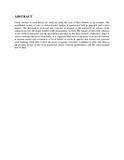| dc.contributor.author | Raikes, P. | |
| dc.date.accessioned | 2014-04-22T10:23:51Z | |
| dc.date.available | 2014-04-22T10:23:51Z | |
| dc.date.issued | 1989 | |
| dc.identifier.citation | Working Paper - Institute for Development Studies, University of Nairobi 1989 pp. 56pp. | en_US |
| dc.identifier.uri | http://www.cabdirect.org/abstracts/19901881250.html | |
| dc.identifier.uri | http://hdl.handle.net/11295/65902 | |
| dc.description.abstract | Credit savings in rural Kenya are analysed using the case of Kisii District as an example. The established notion of state or donor-funded lending is questioned both in principle and overall impact. The literature is reviewed and evidence in support of the popularity of private credit transactions over the donor funded credit programmes is cited. The impact of the credit schemes of the 1970s is discussed and the information provided by the Kisii farmers' cooperative union is used to examine the use of loan funds. It is suggested that most of the loans went into investment in human capital and conversion of local breeds of cattle. It appears that formal and informal rural banking, while able to meet the needs of regular customers, cooperate to offer very little to the poorest section of the rural population except extreme indebtedness and the consequential loss of land. | en_US |
| dc.language.iso | en | en_US |
| dc.publisher | University of Nairobi | en_US |
| dc.title | Credit Systems In Rural Kenya: An Example From Kisii. | en_US |
| dc.type | Working Paper | en_US |

